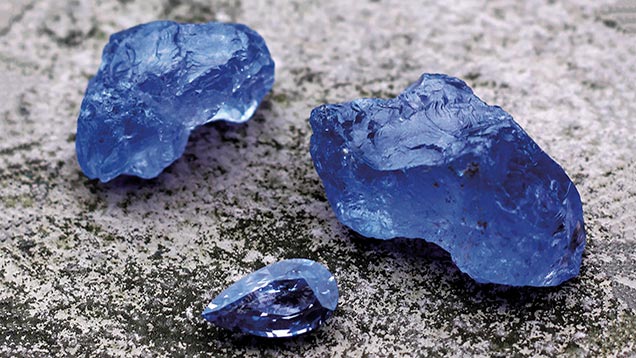In the vast and captivating world of gemstones, two exquisite treasures hold a special place – Blue Spinel and Synthetic Opal. These gemstones, though distinct in their origins, are celebrated for their striking beauty and unique qualities. As we embark on a journey to explore the mesmerizing realm of Blue Spinel and Synthetic Opal, we will uncover their history, properties, uses, and why they continue to captivate the hearts of gem enthusiasts around the world.
Blue Spinel: A True Gem
Blue Spinel, also known as the “Stone of Immortality,” is a magnificent gemstone renowned for its deep and alluring blue hue. Its lustrous and vibrant appearance has earned it a prominent place in the world of jewelry and gemstone collectors.
History Of Blue Spinel
The history of Blue Spinel dates back to ancient times, where it was often mistaken for other precious blue gemstones, such as sapphire. One of the most famous spinel gemstones, the “Timur Ruby,” which adorns the British Crown Jewels, was later discovered to be a spinel instead of a ruby. This historical mix-up emphasizes the gem’s rarity and allure.
Properties Of Blue Spinel
- Color: The most prominent feature of Blue Spinel is its captivating blue color, which can range from a deep royal blue to a mesmerizing pastel shade. The presence of various trace elements, especially iron and cobalt, contributes to the stone’s distinctive hues.
- Clarity: Blue Spinel often exhibits excellent clarity, allowing light to pass through the gem, creating a stunning play of colors and reflections.
- Durability: With a hardness of 8 on the Mohs scale, Blue Spinel is durable and resistant to scratches, making it suitable for a wide range of jewelry applications.
- Cut: Blue Spinel is often cut into various shapes, such as round, oval, and cushion cuts, to enhance its brilliance and beauty.
- Luster: Its exceptional luster adds to its mesmerizing appeal, making it a perfect choice for engagement rings, earrings, and other jewelry pieces.
Synthetic Opal: A Work Of Art
Synthetic Opal, a man-made marvel, is a gemstone designed to replicate the stunning appearance of natural opal while offering greater durability and affordability.
History Of Synthetic Opal
The concept of synthetic opal emerged in the 1970s as scientists endeavored to mimic the natural opal’s iridescent play-of-color. The breakthrough led to the creation of Synthetic Opal, which quickly gained popularity among jewelry designers and enthusiasts.
Properties Of Synthetic Opal
- Composition: Synthetic Opal is composed of tiny silica spheres arranged in a unique lattice structure, creating the same iridescent effect seen in natural opal.
- Color Play: The most fascinating feature of Synthetic Opal is its mesmerizing play-of-color. This opalescent display of vibrant colors is a result of the diffraction of light within the gem.
- Durability: Unlike natural opal, which is fragile and prone to cracking, Synthetic Opal is much more durable and resilient, making it a practical choice for jewelry.
- Affordability: Synthetic Opal offers a cost-effective alternative to natural opal, allowing more people to enjoy its captivating beauty.
- Variety: Synthetic Opal comes in a wide array of colors and patterns, providing endless design possibilities for jewelry makers.
Blue Spinel Vs. Synthetic Opal: A Comparative Analysis
Origin
Blue Spinel is a natural gemstone formed deep within the Earth’s crust, typically found in locations like Sri Lanka, Myanmar, and Vietnam. On the other hand, Synthetic Opal is man-made, created in laboratories using advanced techniques to replicate the stunning visual effects of natural opal.
Color
Blue Spinel is renowned for its rich blue hues, whereas Synthetic Opal dazzles with its opalescent play-of-color, offering a spectrum of colors and patterns.
Durability
Blue Spinel, with a hardness of 8 on the Mohs scale, is highly durable and suitable for everyday wear. Synthetic Opal is even more durable, with no risk of cracking, unlike natural opal, which can be quite fragile.
Price
Blue Spinel is a natural gemstone, and its price can vary significantly based on factors such as color, size, and clarity. Synthetic Opal, being a man-made gem, is generally more affordable, making it an accessible choice for jewelry enthusiasts.
Applications
Blue Spinel is widely used in various jewelry pieces, including engagement rings, pendants, and earrings. Synthetic Opal is a popular choice for crafting colorful and vibrant jewelry designs, often used in necklaces, bracelets, and earrings.
The Allure of Blue Spinel and Synthetic Opal in Jewelry
Both Blue Spinel and Synthetic Opal hold a special place in the hearts of jewelry designers and enthusiasts, each bringing its unique charm to the world of gemstone jewelry.
Blue Spinel In Jewelry
- Engagement Rings: The deep blue color of Blue Spinel makes it a popular choice for engagement rings. Its symbolism of sincerity and commitment enhances its desirability as a gemstone for this special occasion.
- Pendants and Necklaces: Blue Spinel’s lustrous appearance shines brightly in pendant designs, where it can be the centerpiece of a necklace, accentuating the wearer’s elegance.
- Earrings: Blue Spinel earrings, whether set as studs or dangles, add a touch of sophistication and luxury to any ensemble.
- Collector’s Pieces: Rare and exceptional Blue Spinels are highly sought after by gemstone collectors, who appreciate the gem’s historical significance and unique beauty.
Synthetic Opal In Jewelry
- Colorful Creations: The iridescent play-of-color exhibited by Synthetic Opal makes it perfect for creating vibrant and colorful jewelry designs. From playful necklaces to artistic earrings, the gem’s opalescence adds a whimsical touch to any piece.
- Affordable Luxury: Synthetic Opal allows individuals to enjoy the beauty of opal without the high price tag associated with natural opal, making it an ideal choice for those looking for affordable luxury.
- Custom Designs: Jewelry makers often use Synthetic Opal to craft custom designs, incorporating the gem’s mesmerizing play-of-color into unique and personalized pieces.
The Growing Popularity Of Lab-Created Gemstones
In recent years, lab-created gemstones, including Synthetic Opal, have gained significant popularity. This is due to several factors, including ethical concerns surrounding the sourcing of natural gemstones, as well as the desire for more affordable options that don’t compromise on beauty.
Ethical Sourcing: Lab-created gemstones like Synthetic Opal eliminate concerns about ethical issues related to the mining and sourcing of natural gemstones. Consumers who prioritize sustainability often turn to synthetic options.
Affordability: Synthetic gemstones are more budget-friendly, offering individuals the opportunity to own beautiful and high-quality gemstones without breaking the bank.
Innovative Designs: Jewelry designers and artisans are drawn to the creative possibilities offered by synthetic gems, allowing them to craft unique and imaginative pieces.
The Appeal of Collecting Blue Spinel
For gemstone collectors, Blue Spinel holds a distinct charm. Its rarity, historical significance, and captivating beauty make it a prized addition to any collection.
Collectibility: Blue Spinel’s scarcity and historic confusion with other gemstones add to its allure as a collector’s item.
Investment Potential: Exceptional Blue Spinels have shown a history of increasing value, making them a potential investment for those with an eye for gemstone appreciation.
Aesthetic Beauty: Collectors are drawn to the deep blue color and dazzling brilliance of Blue Spinel, appreciating its aesthetic appeal.
Caring For Blue Spinel And Synthetic Opal
Proper care and maintenance are essential to ensure the longevity and beauty of both Blue Spinel and Synthetic Opal jewelry.
Cleaning Blue Spinel Jewelry
- Use a mild soap and warm water solution to gently clean Blue Spinel jewelry.
- A soft brush or cloth can be used to remove dirt and grime, but avoid abrasive materials that could scratch the gem.
- Rinse the jewelry thoroughly and pat it dry with a soft, lint-free cloth.
- Store Blue Spinel jewelry in a fabric-lined box or pouch to prevent scratching.
Cleaning Synthetic Opal Jewelry
- Clean Synthetic Opal jewelry using a soft, damp cloth or a gentle jewelry cleaner.
- Avoid using harsh chemicals or abrasive materials that may damage the surface.
- Dry the jewelry thoroughly and store it in a soft pouch or box to prevent contact with other hard jewelry pieces.
Conclusion
The world of gemstones is a treasure trove of beauty, history, and symbolism, and two gems that shine brightly within this world are Blue Spinel and Synthetic Opal. While Blue Spinel boasts its natural allure, deep blue hues, and rich history, Synthetic Opal captures the imagination with its opalescent play-of-color and versatility. Whether you’re drawn to the deep and enchanting beauty of Blue Spinel or the vibrant and affordable charm of Synthetic Opal, both gems offer a world of possibilities for jewelry enthusiasts and collectors alike. Ultimately, their individual allure and unique qualities continue to captivate and inspire those who have the privilege of wearing or owning these magnificent gemstones.



















